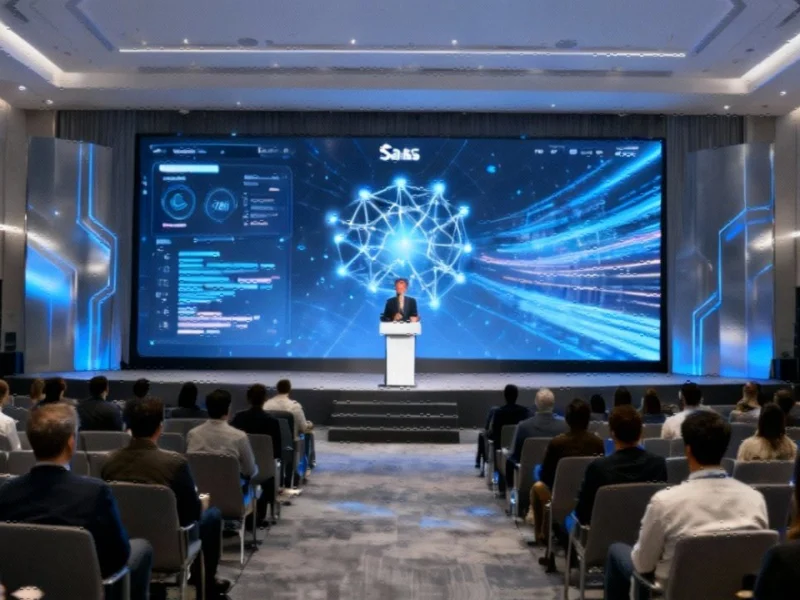Note: Featured image is for illustrative purposes only and does not represent any specific product, service, or entity mentioned in this article.
Agentic AI Emerges as Salesforce’s Next Frontier
Salesforce’s Dreamforce 2025 conference has positioned agentic artificial intelligence as the cornerstone of the company’s future strategy, with CEO Marc Benioff declaring this technology shift represents “the next revolution” in enterprise software. The announcement of Salesforce Agentforce 360’s general availability signals a significant pivot toward autonomous AI systems that can execute complex business processes without constant human intervention.
Benioff’s vision of bridging the “agentic divide” between consumer and enterprise AI capabilities comes as businesses increasingly seek to automate customer service, sales operations, and data analysis. “We’ve gone through cloud, we’ve gone through mobile, we’ve gone through social, we’ve gone through predictive AI,” Benioff stated during his keynote. “Now we’re entering this new agentic AI revolution.”
Channel Partners Adapt to New AI Implementation Realities
Solution providers are quickly recognizing that Salesforce’s AI push requires fundamental changes in how they approach client engagements. Michael Utell, chief commercial officer for Bridgenext’s Salesforce practice, explained that much of his team’s work now involves helping clients understand Agentforce’s capabilities while preparing them for the transition to becoming agentic enterprises.
“We’re trying to help our clients not just implement Salesforce—there’s a lot of fish in the sea that go and implement Salesforce—but truly understand why they are implementing and what return they’re getting,” Utell told CRN. This approach reflects the evolving broader technology landscape where AI implementation requires deeper strategic consultation beyond traditional software deployment.
Many clients still require extensive data cleanup and preparation work to maximize the value of Salesforce’s AI offerings, creating new service opportunities for partners. Bridgenext has developed a unique practice combining Salesforce management with product development expertise to address these emerging needs.
Financial Ambitions Meet Market Realities
Salesforce’s bold $60 billion revenue target by fiscal 2030 underscores the company’s confidence in its AI-driven growth strategy. However, investment firm William Blair noted in a recent report that while Salesforce appears well-positioned for medium and long-term success with generative AI, the vendor faces near-term challenges as many Agentforce capabilities remain in development.
The transparency around Salesforce’s growth plans over the next 18 months provides partners with clearer guidance for their own strategic planning. As enterprise infrastructure evolves to support advanced AI workloads, solution providers must balance immediate implementation opportunities with longer-term platform development.
Competitive Pressures Reshape SaaS Landscape
Bernstein analysts highlighted Salesforce’s unique advantage as a holder of extensive enterprise data, positioning the company to lead in delivering AI agents. However, the traditional per-seat pricing model of flagship products like Service Cloud faces disruption from AI-driven alternatives, while both technology giants and startups challenge Salesforce in its core CRM market.
Salesforce’s expansion into new markets, particularly the IT service domain dominated by ServiceNow, presents additional complexity. Bernstein predicted that Salesforce will likely find more success leveraging AI in its established markets where it possesses richer data and context, rather than in newer domains where it lacks comparable expertise.
These competitive dynamics are unfolding alongside broader infrastructure transformations that are reshaping how enterprises deploy and manage technology solutions.
Implementation Considerations for Channel Partners
Solution providers navigating Salesforce’s AI ecosystem should consider several critical factors:
- Data readiness assessments: Most clients require significant data preparation before achieving meaningful AI results
- Change management expertise: Transitioning to agentic operations requires substantial organizational adaptation
- Integration capabilities: Connecting Salesforce AI with existing systems and emerging connectivity solutions becomes increasingly important
- ROI measurement frameworks: Demonstrating clear business value from AI investments is essential for client retention
The rapid pace of AI hardware innovation creates both opportunities and challenges for implementation partners, who must stay current with evolving technology stacks while ensuring stable client deployments.
Strategic Implications for the Channel
Salesforce’s aggressive AI roadmap signals a fundamental shift in how solution providers will engage with enterprise clients. Partners must develop deeper expertise in AI implementation strategies while helping clients navigate the organizational changes required for successful agentic enterprise transformation.
As scientific advancements continue to influence technology development, the intersection of biological and artificial intelligence systems may create future opportunities for innovative solution providers. The channel’s ability to adapt to these rapidly evolving market conditions will determine which partners thrive in the AI-driven enterprise landscape.
Salesforce’s Dreamforce announcements ultimately point toward a future where AI agents handle increasingly complex business processes, with channel partners serving as essential guides through this transformation. The success of this vision will depend not only on Salesforce’s technology execution but on the ecosystem’s ability to deliver tangible business outcomes through thoughtful implementation and strategic guidance.
This article aggregates information from publicly available sources. All trademarks and copyrights belong to their respective owners.



